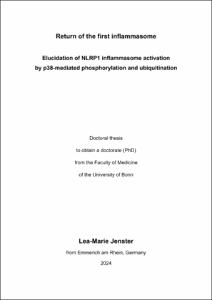Return of the first inflammasomeElucidation of NLRP1 inflammasome activation by p38-mediated phosphorylation and ubiquitination
Return of the first inflammasome
Elucidation of NLRP1 inflammasome activation by p38-mediated phosphorylation and ubiquitination
| dc.contributor.advisor | Schmidt, Florian Ingo | |
| dc.contributor.author | Jenster, Lea-Marie | |
| dc.date.accessioned | 2024-01-31T11:02:45Z | |
| dc.date.issued | 30.01.2024 | |
| dc.identifier.uri | https://hdl.handle.net/20.500.11811/11284 | |
| dc.description.abstract | The assembly of inflammasomes is linked to the detection of pathogens and other danger signals by intracellular pattern-recognition receptors of the mammalian innate immune system. The human inflammasome sensor NLRP1 is activated by N-terminal proteolytic cleavage and subsequent degradation, causing the release of the C-terminal NLRP1UPA-CARD fragment and the recruitment of the adaptor protein ASC and caspase-1, resulting in the processing of IL-1β/IL-18 and pyroptotic cell death. To study NLRP1 inflammasomes, I characterized HEK 293T and N/TERT-1 keratinocyte inflammasome reporter cell lines, and I identified two NLRP1PYD-specific nanobodies which, combined with the E3 ligase receptor VHL, allowed the precise stimulation of endogenous NLRP1 by targeted NLRP1PYD ubiquitination and subsequent N-terminal degradation. Using the reporter cell lines, I found that various stimuli of the ribotoxic stress response activate human NLRP1 in a p38-dependent manner. In addition, infection with alphaviruses, including Semliki Forrest virus and Chikungunya virus, caused p38-dependent NLRP1 activation. p38 kinases directly phosphorylate the N-terminal linker region of the inflammasome sensor, in which serine 107 represents a critical phosphorylation site. I propose that phosphorylation of the N-terminal linker generates a phospho-degron which is recognized by cullin RING E3 ligases, causing the ubiquitination of NLRP1PYD, N-terminal degradation, and inflammasome assembly. In addition to delineating p38-mediated NLRP1 activation, I identified novel viral NLRP1 stimuli and established lymphocytes as NLRP1-competent cell types. | en |
| dc.language.iso | eng | |
| dc.rights | In Copyright | |
| dc.rights.uri | http://rightsstatements.org/vocab/InC/1.0/ | |
| dc.subject | Inflammasome | |
| dc.subject | NLRP1 | |
| dc.subject | Nanobodies | |
| dc.subject | ribotoxischer Stress | |
| dc.subject | p38 | |
| dc.subject | Alphavirus | |
| dc.subject | Rotavirus | |
| dc.subject | T Zellen | |
| dc.subject | Inflammasomes | |
| dc.subject | ribotoxic stress | |
| dc.subject | T cells | |
| dc.subject.ddc | 570 Biowissenschaften, Biologie | |
| dc.title | Return of the first inflammasome | |
| dc.title.alternative | Elucidation of NLRP1 inflammasome activation by p38-mediated phosphorylation and ubiquitination | |
| dc.type | Dissertation oder Habilitation | |
| dc.publisher.name | Universitäts- und Landesbibliothek Bonn | |
| dc.publisher.location | Bonn | |
| dc.rights.accessRights | embargoedAccess | |
| dc.date.embargoEndDate | 01.02.2026 | |
| dc.identifier.urn | https://nbn-resolving.org/urn:nbn:de:hbz:5-74405 | |
| dc.relation.doi | https://doi.org/10.1084/jem.20220837 | |
| ulbbn.pubtype | Erstveröffentlichung | |
| ulbbnediss.affiliation.name | Rheinische Friedrich-Wilhelms-Universität Bonn | |
| ulbbnediss.affiliation.location | Bonn | |
| ulbbnediss.thesis.level | Dissertation | |
| ulbbnediss.dissID | 7440 | |
| ulbbnediss.date.accepted | 11.01.2024 | |
| ulbbnediss.institute | Medizinische Fakultät / Institute : Institut für Angeborene Immunität | |
| ulbbnediss.fakultaet | Medizinische Fakultät | |
| dc.contributor.coReferee | Garbi, Natalio | |
| ulbbnediss.contributor.orcid | https://orcid.org/0000-0001-8580-4590 |
Files in this item

This document has got an embargo.
This item appears in the following Collection(s)
-
E-Dissertationen (1997)



